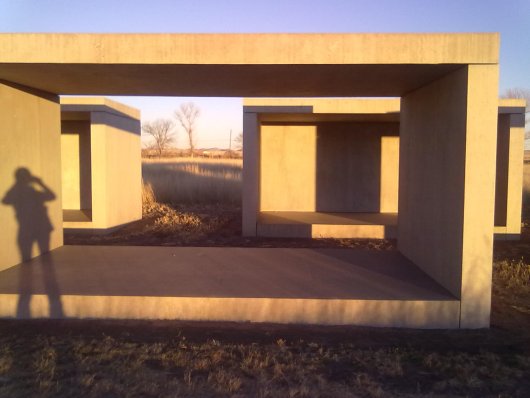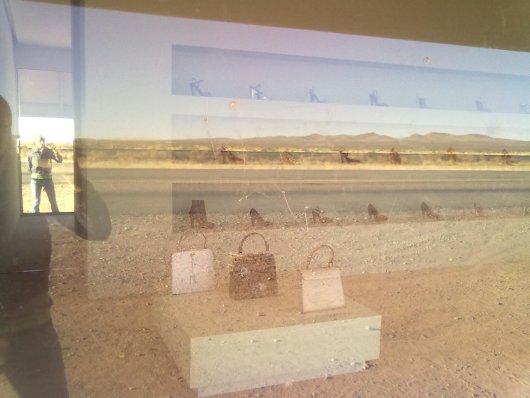 ART
ART In Which We Hover Outside The Story
 Tuesday, June 19, 2012 at 11:56AM
Tuesday, June 19, 2012 at 11:56AM 
Rules of the Trade
by SARAH WAMBOLD
Grant Wood famously had his studio in the Turner Mortuary carriage house in Cedar Rapids, Iowa. He fashioned a door to the studio out of an old coffin lid. He carved a dial into the front of it to indicate what he was doing and if he could accept visitors. The arrow most frequently toggled between “Taking a bath” and “Having a Party”.
The owner of the mortuary, David Turner, held the belief that all artists were ‘sissies’, however he was an old friend of Wood’s and considered him to be different. He liked the regional aspect of Wood’s paintings and their depiction of the honest Midwestern life. The homespun aesthetic made for good, gentle beauty; just perfect for a funeral home. He commissioned Wood to decorate the mortuary with his work and create their advertising. If you visit a funeral home or even look at any mortuary website today, the framed paintings and banner images continue on in this tradition.

Grant Wood is widely believed to have been a closeted homosexual who inserted this secret into nearly all of his paintings. It seems possible that the people closest to him knew this, but they refused to address it. He refused to address it himself. Being an artist in Iowa in the 1930s was precarious enough. Squashing down a part of yourself for the sake of your work only makes it seep out around the edges. The naked males in the background of Arnold Comes of Age have their backs to Arnold and he to them, but they both know they’re there.
The first funeral home I worked at made me take out all of my earrings. I couldn’t wear my hair in braids. I wore the same black suit, literally, for two years. It was built out of polyester that never tired of washings or blood. I started painting my each of my nails a different shade of red, the only color acceptable to wear during work. If I wasn’t at work on the weekends, I mismatched the brightest clothing in my closet and wore ill-advised cornrows in my hair.

Wood loved Iowa, yet he knew he did not fit in there. But because he loved the Iowa, he didn’t fit in anywhere else either. He painted Iowa the way he saw it and the way he hoped it saw him: clean, simple, innocent. Rough edges were made smooth, leering townspeople given ironic humor; menacing roads appear like ribbons. The mortuary could be Woods' home if he kept it clean - his studio and his art. No impressionistic, Greenwich Village types allowed. Wood more than complied; he clung to Regionalism. Regionalism, like state politics, is infuriating to most and admired by others.
When funeral directors tell stories about work, they tell the ones they think people will find the most interesting. They are the same stories over and over; the same as every other funeral director. Mishaps with makeup, strange deaths, feuding families. The stories are actually only interesting around the edges, hovering just outside the story. Conspiracy theories on talk radio while embalming, Merzbow rattling inside the hearse, smoke from cigarettes wafting into the sanctuary during funeral mass and weed all over during lunch breaks.
Subversion of rules even in the smallest sense, simply to make ourselves fit somewhere into the work, is the highest form of acknowledgement.

Twice Grant Wood went to Europe and each time he made a small impression. But upon his return to Iowa he and Europe forgot about each other. He tried to paint the European landscape in his regionalist technique but it didn’t take. He saw his figures becoming shadowy, bare and romantic; places he wasn’t equipped to explore. In Iowa, he could depict his life experience while charming his audience. Wood felt it was his obligation to confront his people in their own language, using his own art. He stayed true to that idea and was poor his whole life.
Funeral directors fade away at the presence of a dead body. They stand quietly in the corner, offering direction so no one else has to think about what they are seeing. They make death recognizable to the grieving, be it in the form of a body, a box or a tree. There is a nod towards reality but like Wood’s paintings, it’s draped in tenderness. This is the default emotion of death, sex and Grant Wood’s art. It is spiritless unless you are engaged with it. It’s hard to look at otherwise. When a hearse drives by, it’s not the name of the dead that is in the window. We do little more than wonder who is inside.
Sarah Wambold is the senior contributor to This Recording. She is a writer living in Austin. You can find her twitter here. She last wrote in these pages about her trip to Marfa.

"Cosmic Radio" - Wet Hair (mp3)
"Tarantula" - Wet Hair (mp3)

 grant wood,
grant wood,  sarah wambold
sarah wambold 









































